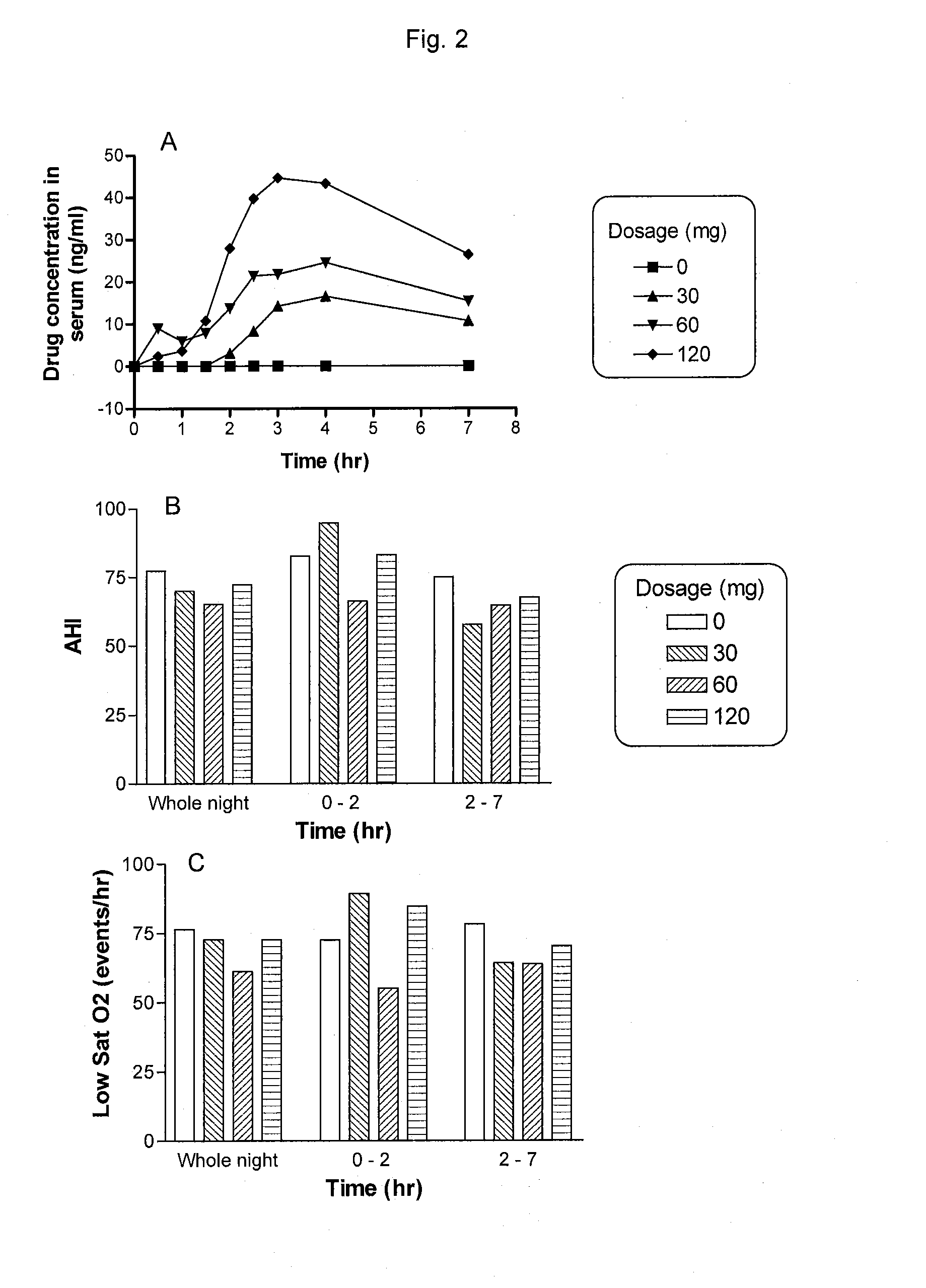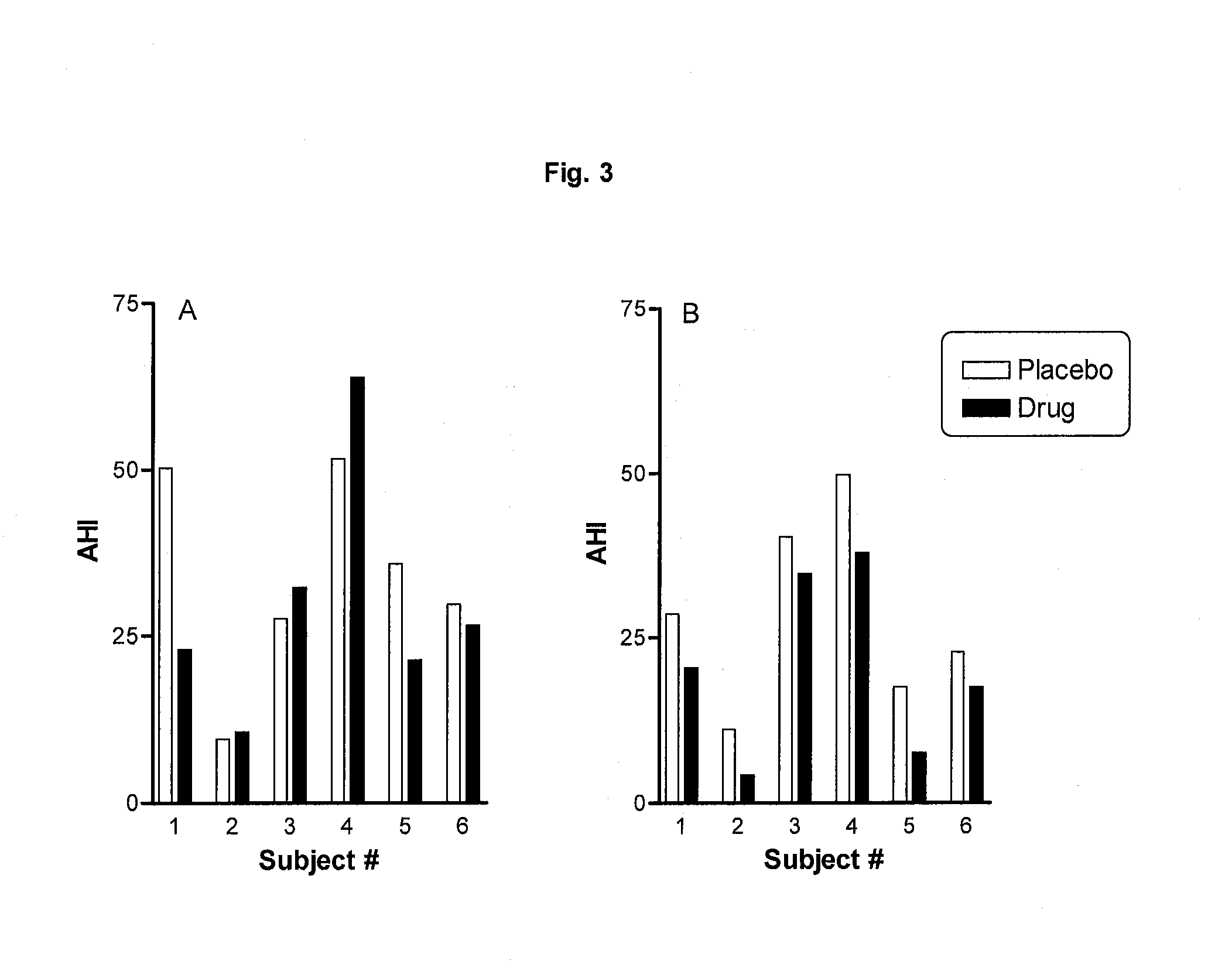Methods for treating obstructive sleep apnea
a technology for obstructive sleep apnea and sleep apnea, which is applied in the field of methods for treating obstructive sleep apnea, can solve the problems of frequent loss of memory, poor sleep quality, and low oxygen saturation, and achieve the effects of reducing ahi, reducing total apnea/hypopnea time, and reducing snoring
- Summary
- Abstract
- Description
- Claims
- Application Information
AI Technical Summary
Benefits of technology
Problems solved by technology
Method used
Image
Examples
example 1
Determination of Effective Serum Concentrations of PYD in OSA Patients
[0083]A randomized, double-blind, placebo-controlled, crossover study with PYD was undertaken in 12 patients with moderate to severe OSA. PYD was prepared by grinding pyridostigmine bromide pills manufactured by Sunve Pharmaceutical Co., LTD., Shanghai, China and recapsulated into hard shell capsules. PYD bromide at 30 mg, 60 mg, 120 mg, or placebo was orally administered to patients before sleep each night for a total of four continuous nights. Lights went out within 5 min after the administration. Blood was drawn at 0, 0.5, 1, 1.5, 2, 2.5, 3, 4 and 7 hours after the administration, and serum drug concentrations were determined by a LC-MS method after proper pre-treatment of the blood samples. Patients were monitored by either a PSG or a PM throughout the nights.
[0084]The serum drug concentrations in the patients are shown in FIG. 1. The peak serum drug concentration was found between 3-4 hours. The patients resp...
example 2
Evaluation of the Efficacy and Safety of PYD in Subjects with OSA
[0089]A double-blind, randomized, cross-over, placebo-controlled study was conducted to evaluate the efficacy and safety of PYD in 6 diagnosed OSA patients. The study consists of a one-day acclimatization period followed immediately by a 2-day double-blind treatment period when patients received either 90 mg PYD bromide in hard shell capsules or a matching placebo before sleep with a light snack. All patients were required to maintain in a supine position throughout of the night, as OSA is most severe when patients is on their back. In such a way, the results are expected to be more conservative in judging therapeutic effects of the drug. Lights were turned off within 5 min after the administration of the drug. The patients were monitored by a PSG. Apnea, hypopnea, snoring, blood O2 saturation were monitored, recorded, and scored. Sleep questionnaires were taken everyday after sleep to evaluate the impact on the sleep ...
example 3
Determination of Optimum PYD Dose Range for the Treatment of OSA
[0107]The results obtained from the clinical study described in Example 1 show that the therapeutic effects of PYD did not always correlate with an increased dosage of the drug. For an example, a patient recorded lower AHI and less low O2 saturation when treated with 30-60 mg PYD bromide compared with those treated with 120 mg PYD bromide (FIG. 2). This finding in the dose response is unexpected and unique.
[0108]A randomized, double-blind, dose escalating study was carried out in one patient to determine optimum PYD dose range for treating OSA. The patient was administered to with 30, 60, 90 mg PYD bromide or a placebo before sleep, and was monitored by PSG throughout the night. AHI, AI, and total apnea / hypopnea time were lower in the nights administered with 30 or 60 mg PYD bromide compared with the night with 90 mg PYD bromide (FIG. 9). The number of low O2 saturation events was lower with 60 mg PYD bromide compared w...
PUM
| Property | Measurement | Unit |
|---|---|---|
| concentration | aaaaa | aaaaa |
| concentration | aaaaa | aaaaa |
| concentration | aaaaa | aaaaa |
Abstract
Description
Claims
Application Information
 Login to View More
Login to View More - R&D
- Intellectual Property
- Life Sciences
- Materials
- Tech Scout
- Unparalleled Data Quality
- Higher Quality Content
- 60% Fewer Hallucinations
Browse by: Latest US Patents, China's latest patents, Technical Efficacy Thesaurus, Application Domain, Technology Topic, Popular Technical Reports.
© 2025 PatSnap. All rights reserved.Legal|Privacy policy|Modern Slavery Act Transparency Statement|Sitemap|About US| Contact US: help@patsnap.com



